Importance of Administration in Business Success
VerifiedAdded on 2020/06/04
|16
|3559
|428
AI Summary
This assignment delves into the significance of administration as a driving force behind business growth and sustainability. It examines various administrative tools and strategies employed to enhance meeting effectiveness, including information gathering, feedback mechanisms, and venue selection. The importance of health and safety measures for employees is also highlighted as a key aspect of responsible administration.
Contribute Materials
Your contribution can guide someone’s learning journey. Share your
documents today.
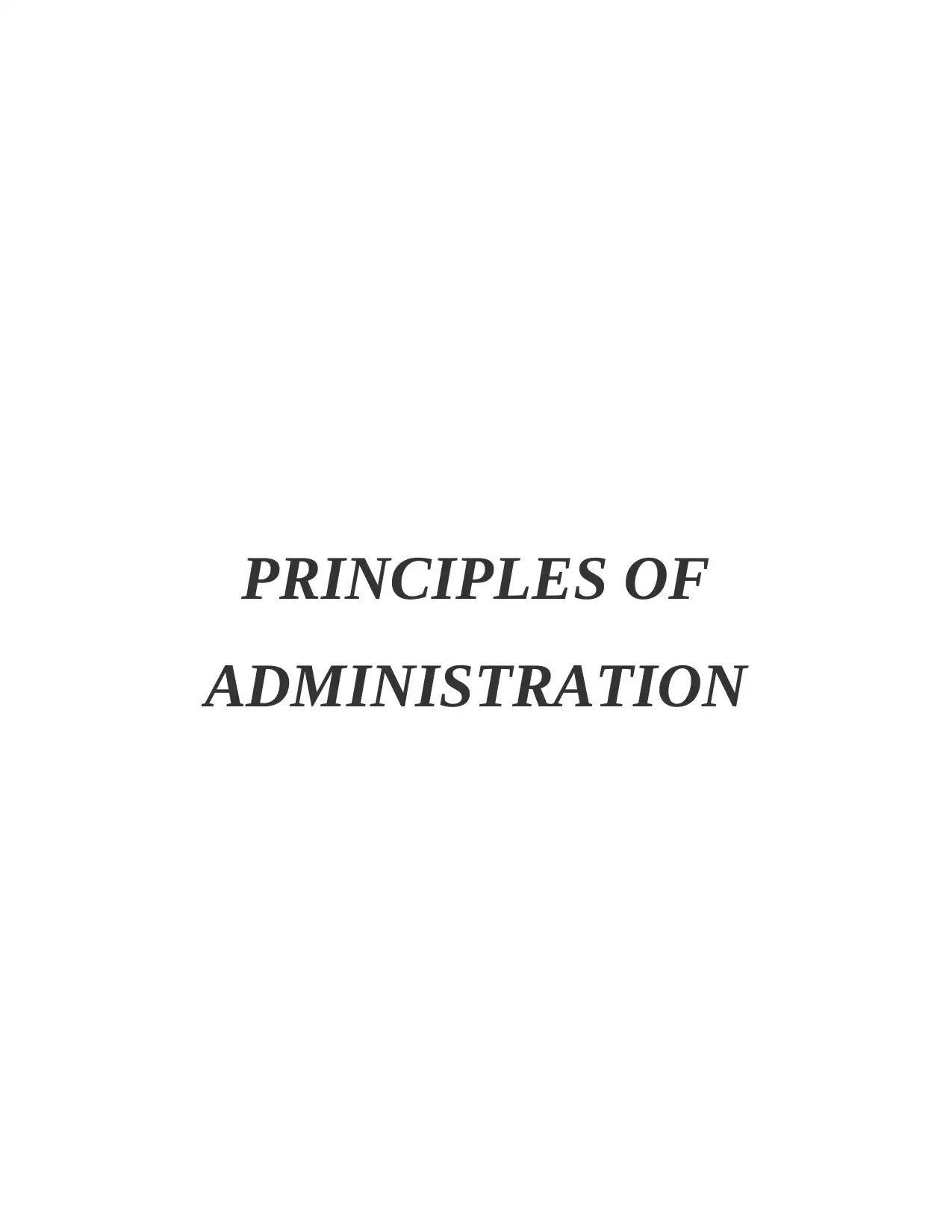
PRINCIPLES OF
ADMINISTRATION
ADMINISTRATION
Secure Best Marks with AI Grader
Need help grading? Try our AI Grader for instant feedback on your assignments.
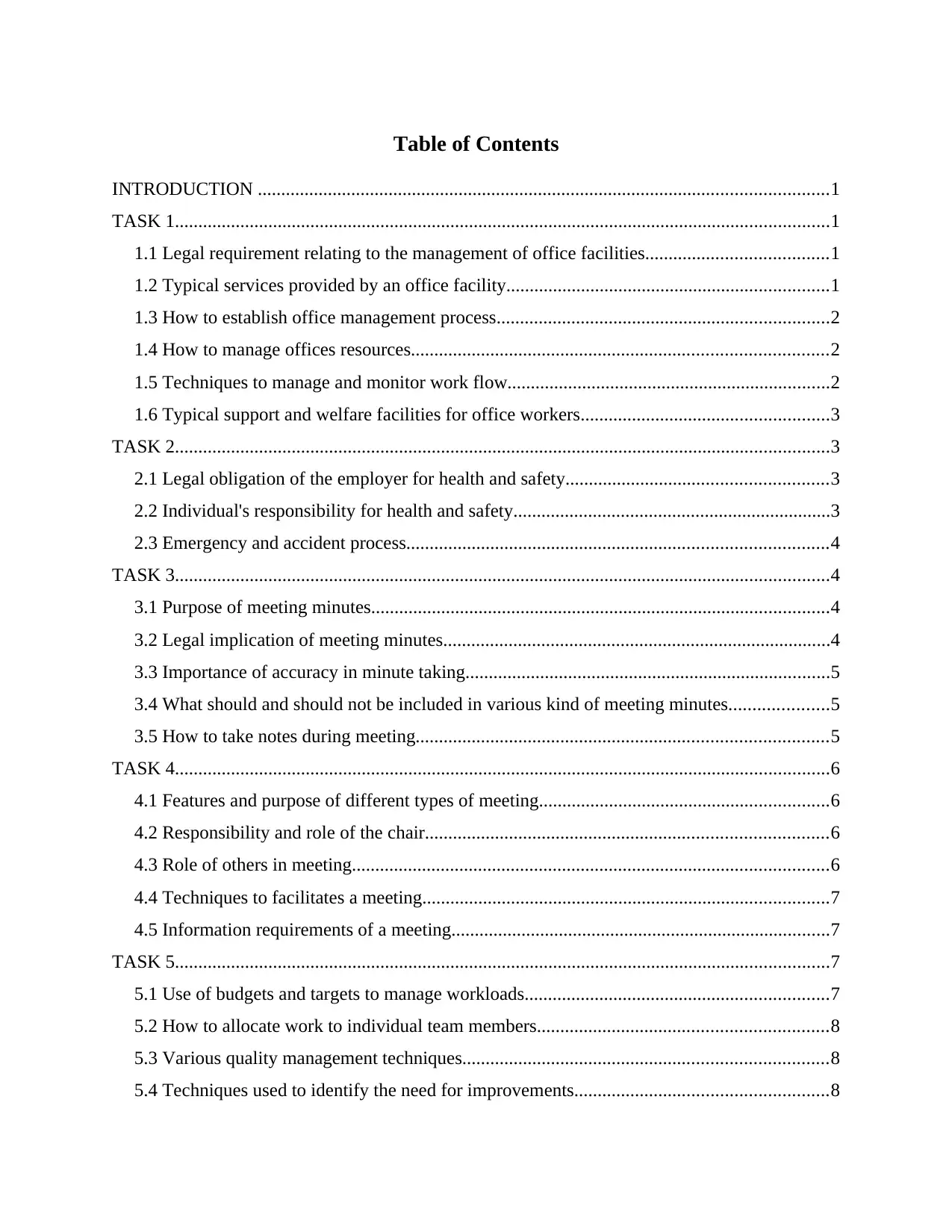
Table of Contents
INTRODUCTION ..........................................................................................................................1
TASK 1............................................................................................................................................1
1.1 Legal requirement relating to the management of office facilities.......................................1
1.2 Typical services provided by an office facility.....................................................................1
1.3 How to establish office management process.......................................................................2
1.4 How to manage offices resources.........................................................................................2
1.5 Techniques to manage and monitor work flow.....................................................................2
1.6 Typical support and welfare facilities for office workers.....................................................3
TASK 2............................................................................................................................................3
2.1 Legal obligation of the employer for health and safety........................................................3
2.2 Individual's responsibility for health and safety....................................................................3
2.3 Emergency and accident process..........................................................................................4
TASK 3............................................................................................................................................4
3.1 Purpose of meeting minutes..................................................................................................4
3.2 Legal implication of meeting minutes...................................................................................4
3.3 Importance of accuracy in minute taking..............................................................................5
3.4 What should and should not be included in various kind of meeting minutes.....................5
3.5 How to take notes during meeting........................................................................................5
TASK 4............................................................................................................................................6
4.1 Features and purpose of different types of meeting..............................................................6
4.2 Responsibility and role of the chair......................................................................................6
4.3 Role of others in meeting......................................................................................................6
4.4 Techniques to facilitates a meeting.......................................................................................7
4.5 Information requirements of a meeting.................................................................................7
TASK 5............................................................................................................................................7
5.1 Use of budgets and targets to manage workloads.................................................................7
5.2 How to allocate work to individual team members..............................................................8
5.3 Various quality management techniques..............................................................................8
5.4 Techniques used to identify the need for improvements......................................................8
INTRODUCTION ..........................................................................................................................1
TASK 1............................................................................................................................................1
1.1 Legal requirement relating to the management of office facilities.......................................1
1.2 Typical services provided by an office facility.....................................................................1
1.3 How to establish office management process.......................................................................2
1.4 How to manage offices resources.........................................................................................2
1.5 Techniques to manage and monitor work flow.....................................................................2
1.6 Typical support and welfare facilities for office workers.....................................................3
TASK 2............................................................................................................................................3
2.1 Legal obligation of the employer for health and safety........................................................3
2.2 Individual's responsibility for health and safety....................................................................3
2.3 Emergency and accident process..........................................................................................4
TASK 3............................................................................................................................................4
3.1 Purpose of meeting minutes..................................................................................................4
3.2 Legal implication of meeting minutes...................................................................................4
3.3 Importance of accuracy in minute taking..............................................................................5
3.4 What should and should not be included in various kind of meeting minutes.....................5
3.5 How to take notes during meeting........................................................................................5
TASK 4............................................................................................................................................6
4.1 Features and purpose of different types of meeting..............................................................6
4.2 Responsibility and role of the chair......................................................................................6
4.3 Role of others in meeting......................................................................................................6
4.4 Techniques to facilitates a meeting.......................................................................................7
4.5 Information requirements of a meeting.................................................................................7
TASK 5............................................................................................................................................7
5.1 Use of budgets and targets to manage workloads.................................................................7
5.2 How to allocate work to individual team members..............................................................8
5.3 Various quality management techniques..............................................................................8
5.4 Techniques used to identify the need for improvements......................................................8
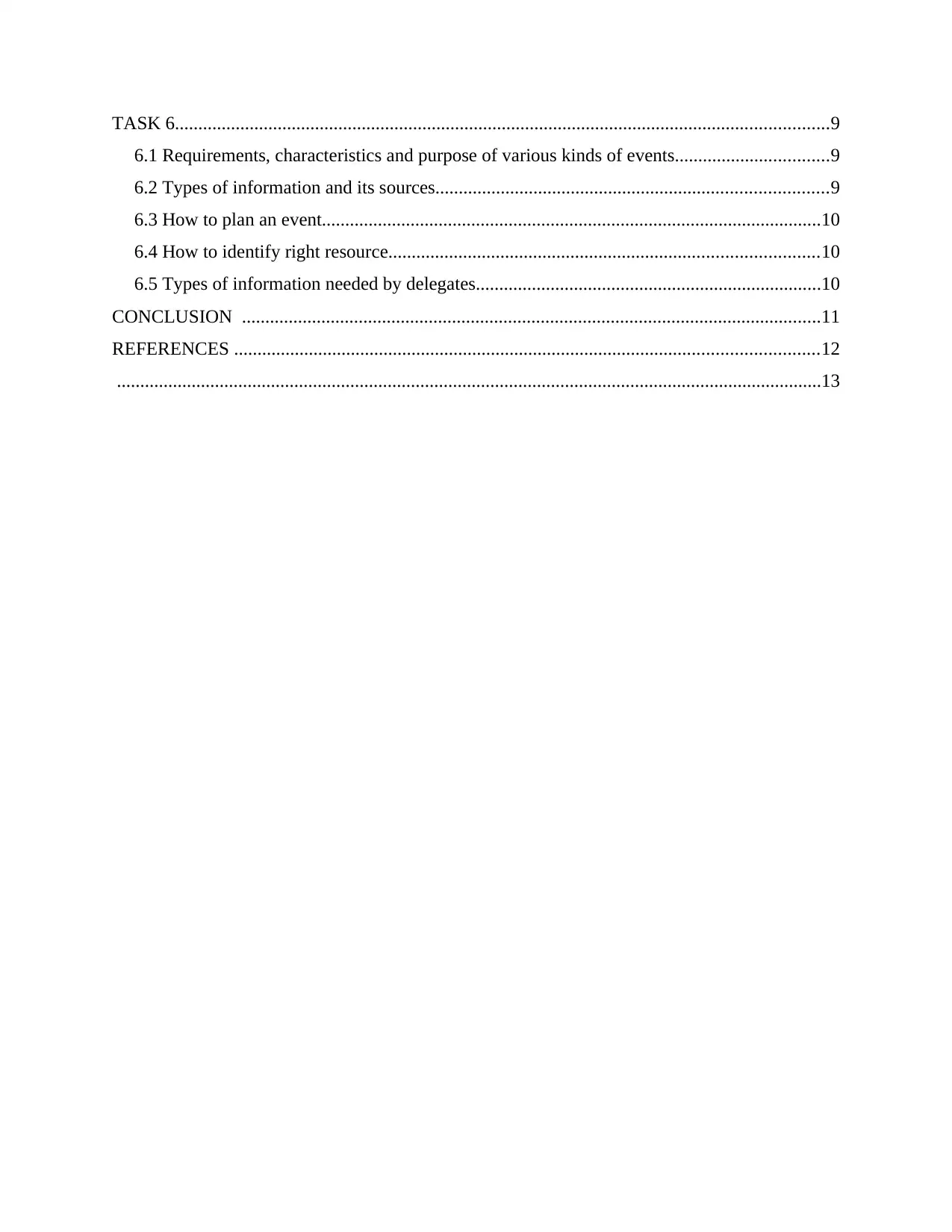
TASK 6............................................................................................................................................9
6.1 Requirements, characteristics and purpose of various kinds of events.................................9
6.2 Types of information and its sources....................................................................................9
6.3 How to plan an event...........................................................................................................10
6.4 How to identify right resource............................................................................................10
6.5 Types of information needed by delegates..........................................................................10
CONCLUSION ............................................................................................................................11
REFERENCES .............................................................................................................................12
.......................................................................................................................................................13
6.1 Requirements, characteristics and purpose of various kinds of events.................................9
6.2 Types of information and its sources....................................................................................9
6.3 How to plan an event...........................................................................................................10
6.4 How to identify right resource............................................................................................10
6.5 Types of information needed by delegates..........................................................................10
CONCLUSION ............................................................................................................................11
REFERENCES .............................................................................................................................12
.......................................................................................................................................................13
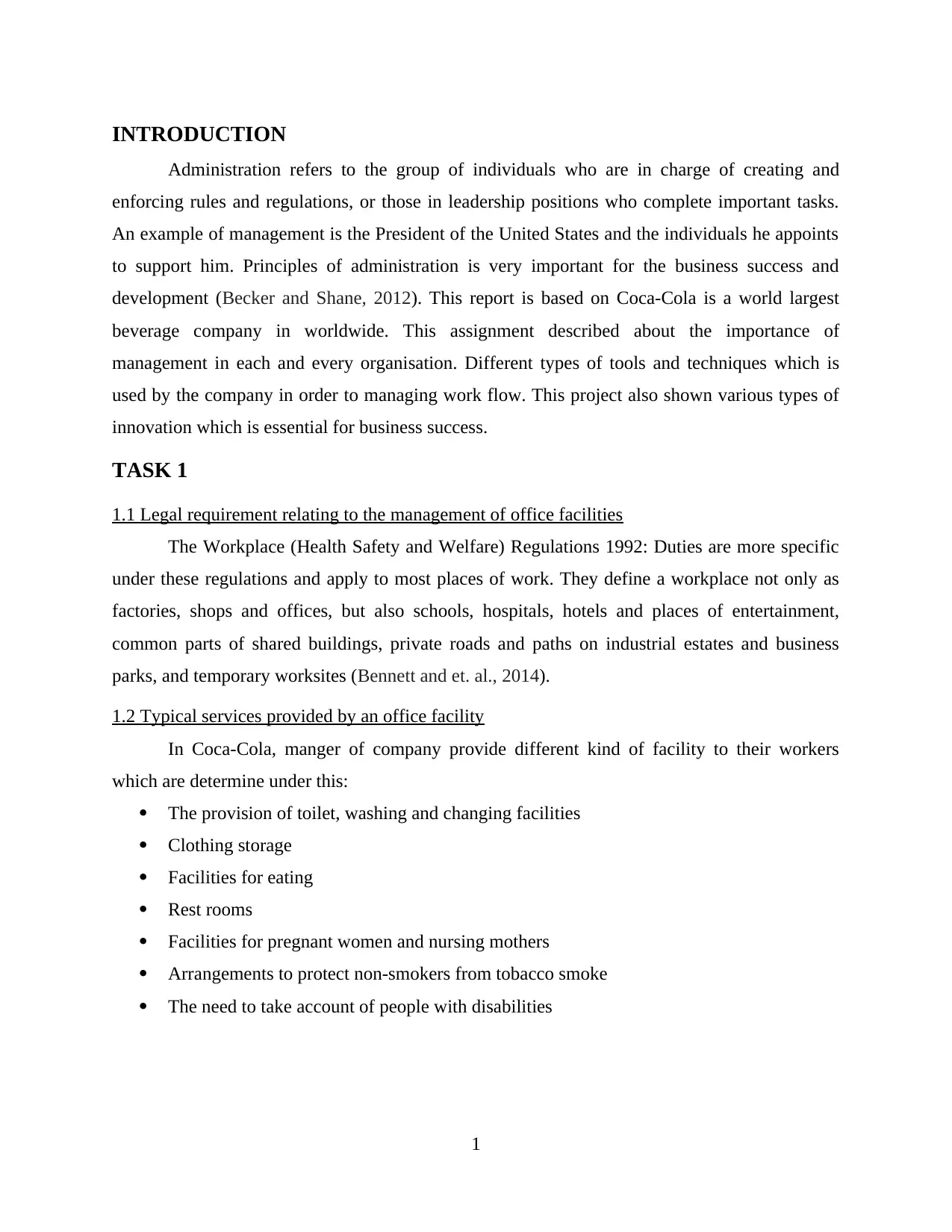
INTRODUCTION
Administration refers to the group of individuals who are in charge of creating and
enforcing rules and regulations, or those in leadership positions who complete important tasks.
An example of management is the President of the United States and the individuals he appoints
to support him. Principles of administration is very important for the business success and
development (Becker and Shane, 2012). This report is based on Coca-Cola is a world largest
beverage company in worldwide. This assignment described about the importance of
management in each and every organisation. Different types of tools and techniques which is
used by the company in order to managing work flow. This project also shown various types of
innovation which is essential for business success.
TASK 1
1.1 Legal requirement relating to the management of office facilities
The Workplace (Health Safety and Welfare) Regulations 1992: Duties are more specific
under these regulations and apply to most places of work. They define a workplace not only as
factories, shops and offices, but also schools, hospitals, hotels and places of entertainment,
common parts of shared buildings, private roads and paths on industrial estates and business
parks, and temporary worksites (Bennett and et. al., 2014).
1.2 Typical services provided by an office facility
In Coca-Cola, manger of company provide different kind of facility to their workers
which are determine under this:
The provision of toilet, washing and changing facilities
Clothing storage
Facilities for eating
Rest rooms
Facilities for pregnant women and nursing mothers
Arrangements to protect non-smokers from tobacco smoke
The need to take account of people with disabilities
1
Administration refers to the group of individuals who are in charge of creating and
enforcing rules and regulations, or those in leadership positions who complete important tasks.
An example of management is the President of the United States and the individuals he appoints
to support him. Principles of administration is very important for the business success and
development (Becker and Shane, 2012). This report is based on Coca-Cola is a world largest
beverage company in worldwide. This assignment described about the importance of
management in each and every organisation. Different types of tools and techniques which is
used by the company in order to managing work flow. This project also shown various types of
innovation which is essential for business success.
TASK 1
1.1 Legal requirement relating to the management of office facilities
The Workplace (Health Safety and Welfare) Regulations 1992: Duties are more specific
under these regulations and apply to most places of work. They define a workplace not only as
factories, shops and offices, but also schools, hospitals, hotels and places of entertainment,
common parts of shared buildings, private roads and paths on industrial estates and business
parks, and temporary worksites (Bennett and et. al., 2014).
1.2 Typical services provided by an office facility
In Coca-Cola, manger of company provide different kind of facility to their workers
which are determine under this:
The provision of toilet, washing and changing facilities
Clothing storage
Facilities for eating
Rest rooms
Facilities for pregnant women and nursing mothers
Arrangements to protect non-smokers from tobacco smoke
The need to take account of people with disabilities
1
Secure Best Marks with AI Grader
Need help grading? Try our AI Grader for instant feedback on your assignments.
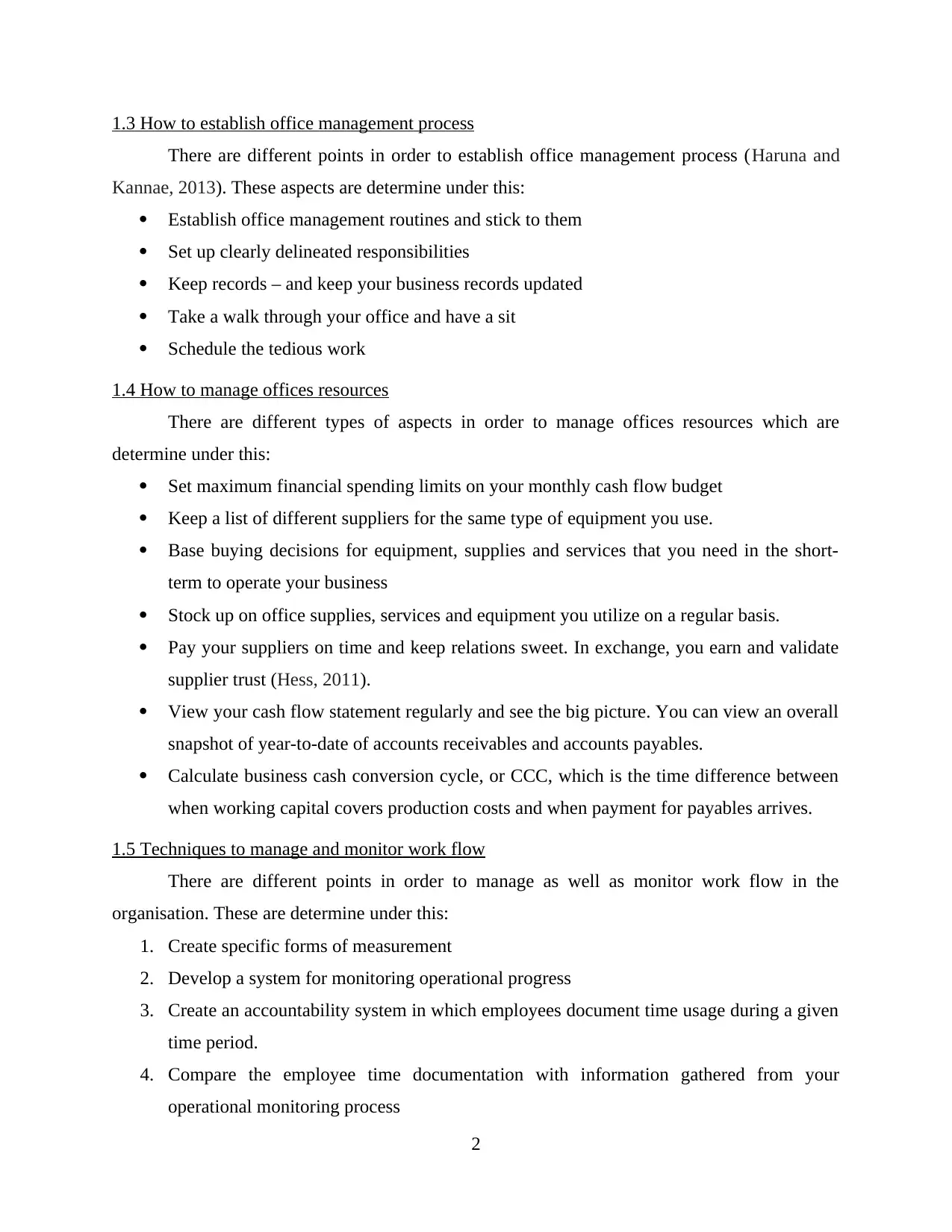
1.3 How to establish office management process
There are different points in order to establish office management process (Haruna and
Kannae, 2013). These aspects are determine under this:
Establish office management routines and stick to them
Set up clearly delineated responsibilities
Keep records – and keep your business records updated
Take a walk through your office and have a sit
Schedule the tedious work
1.4 How to manage offices resources
There are different types of aspects in order to manage offices resources which are
determine under this:
Set maximum financial spending limits on your monthly cash flow budget
Keep a list of different suppliers for the same type of equipment you use.
Base buying decisions for equipment, supplies and services that you need in the short-
term to operate your business
Stock up on office supplies, services and equipment you utilize on a regular basis.
Pay your suppliers on time and keep relations sweet. In exchange, you earn and validate
supplier trust (Hess, 2011).
View your cash flow statement regularly and see the big picture. You can view an overall
snapshot of year-to-date of accounts receivables and accounts payables.
Calculate business cash conversion cycle, or CCC, which is the time difference between
when working capital covers production costs and when payment for payables arrives.
1.5 Techniques to manage and monitor work flow
There are different points in order to manage as well as monitor work flow in the
organisation. These are determine under this:
1. Create specific forms of measurement
2. Develop a system for monitoring operational progress
3. Create an accountability system in which employees document time usage during a given
time period.
4. Compare the employee time documentation with information gathered from your
operational monitoring process
2
There are different points in order to establish office management process (Haruna and
Kannae, 2013). These aspects are determine under this:
Establish office management routines and stick to them
Set up clearly delineated responsibilities
Keep records – and keep your business records updated
Take a walk through your office and have a sit
Schedule the tedious work
1.4 How to manage offices resources
There are different types of aspects in order to manage offices resources which are
determine under this:
Set maximum financial spending limits on your monthly cash flow budget
Keep a list of different suppliers for the same type of equipment you use.
Base buying decisions for equipment, supplies and services that you need in the short-
term to operate your business
Stock up on office supplies, services and equipment you utilize on a regular basis.
Pay your suppliers on time and keep relations sweet. In exchange, you earn and validate
supplier trust (Hess, 2011).
View your cash flow statement regularly and see the big picture. You can view an overall
snapshot of year-to-date of accounts receivables and accounts payables.
Calculate business cash conversion cycle, or CCC, which is the time difference between
when working capital covers production costs and when payment for payables arrives.
1.5 Techniques to manage and monitor work flow
There are different points in order to manage as well as monitor work flow in the
organisation. These are determine under this:
1. Create specific forms of measurement
2. Develop a system for monitoring operational progress
3. Create an accountability system in which employees document time usage during a given
time period.
4. Compare the employee time documentation with information gathered from your
operational monitoring process
2
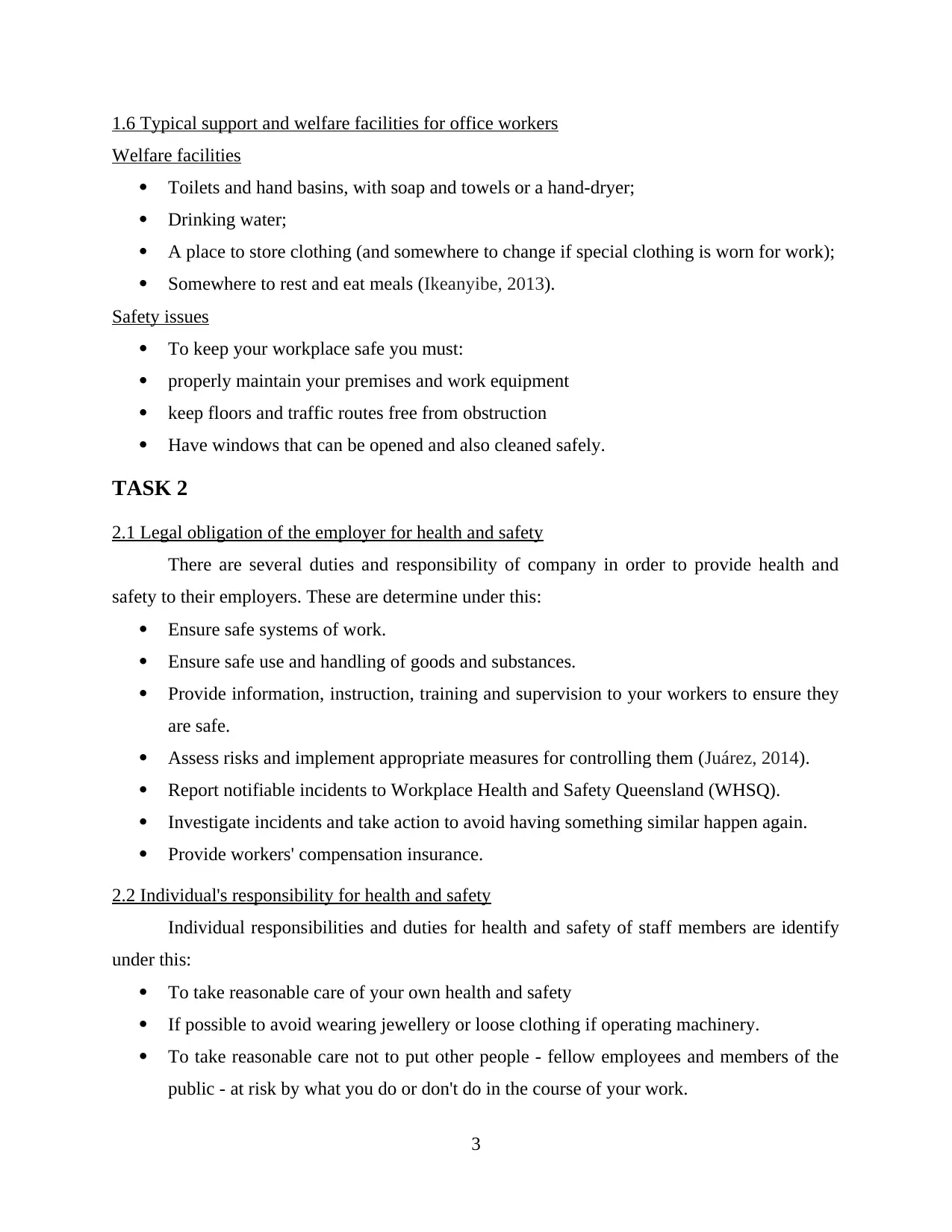
1.6 Typical support and welfare facilities for office workers
Welfare facilities
Toilets and hand basins, with soap and towels or a hand-dryer;
Drinking water;
A place to store clothing (and somewhere to change if special clothing is worn for work);
Somewhere to rest and eat meals (Ikeanyibe, 2013).
Safety issues
To keep your workplace safe you must:
properly maintain your premises and work equipment
keep floors and traffic routes free from obstruction
Have windows that can be opened and also cleaned safely.
TASK 2
2.1 Legal obligation of the employer for health and safety
There are several duties and responsibility of company in order to provide health and
safety to their employers. These are determine under this:
Ensure safe systems of work.
Ensure safe use and handling of goods and substances.
Provide information, instruction, training and supervision to your workers to ensure they
are safe.
Assess risks and implement appropriate measures for controlling them (Juárez, 2014).
Report notifiable incidents to Workplace Health and Safety Queensland (WHSQ).
Investigate incidents and take action to avoid having something similar happen again.
Provide workers' compensation insurance.
2.2 Individual's responsibility for health and safety
Individual responsibilities and duties for health and safety of staff members are identify
under this:
To take reasonable care of your own health and safety
If possible to avoid wearing jewellery or loose clothing if operating machinery.
To take reasonable care not to put other people - fellow employees and members of the
public - at risk by what you do or don't do in the course of your work.
3
Welfare facilities
Toilets and hand basins, with soap and towels or a hand-dryer;
Drinking water;
A place to store clothing (and somewhere to change if special clothing is worn for work);
Somewhere to rest and eat meals (Ikeanyibe, 2013).
Safety issues
To keep your workplace safe you must:
properly maintain your premises and work equipment
keep floors and traffic routes free from obstruction
Have windows that can be opened and also cleaned safely.
TASK 2
2.1 Legal obligation of the employer for health and safety
There are several duties and responsibility of company in order to provide health and
safety to their employers. These are determine under this:
Ensure safe systems of work.
Ensure safe use and handling of goods and substances.
Provide information, instruction, training and supervision to your workers to ensure they
are safe.
Assess risks and implement appropriate measures for controlling them (Juárez, 2014).
Report notifiable incidents to Workplace Health and Safety Queensland (WHSQ).
Investigate incidents and take action to avoid having something similar happen again.
Provide workers' compensation insurance.
2.2 Individual's responsibility for health and safety
Individual responsibilities and duties for health and safety of staff members are identify
under this:
To take reasonable care of your own health and safety
If possible to avoid wearing jewellery or loose clothing if operating machinery.
To take reasonable care not to put other people - fellow employees and members of the
public - at risk by what you do or don't do in the course of your work.
3
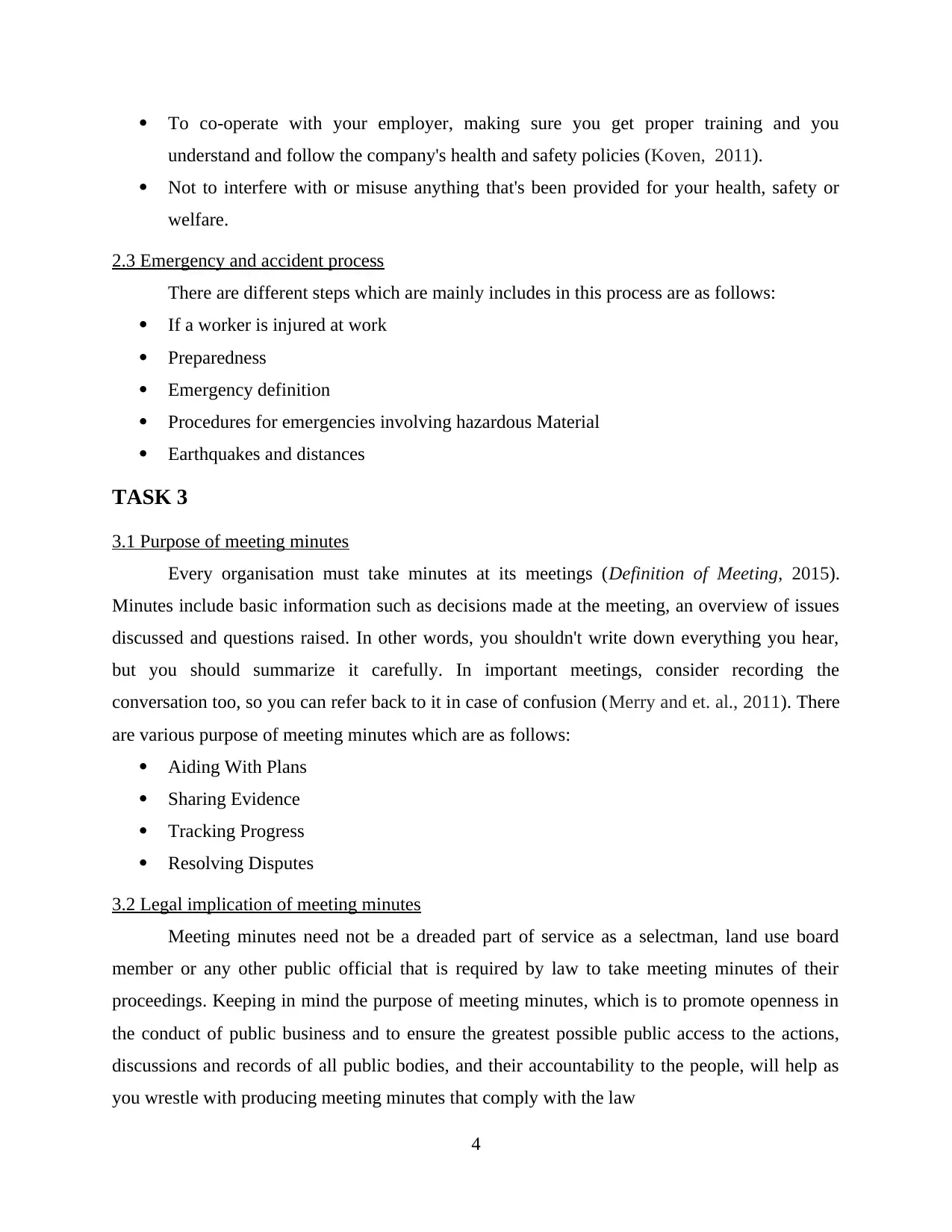
To co-operate with your employer, making sure you get proper training and you
understand and follow the company's health and safety policies (Koven, 2011).
Not to interfere with or misuse anything that's been provided for your health, safety or
welfare.
2.3 Emergency and accident process
There are different steps which are mainly includes in this process are as follows:
If a worker is injured at work
Preparedness
Emergency definition
Procedures for emergencies involving hazardous Material
Earthquakes and distances
TASK 3
3.1 Purpose of meeting minutes
Every organisation must take minutes at its meetings (Definition of Meeting, 2015).
Minutes include basic information such as decisions made at the meeting, an overview of issues
discussed and questions raised. In other words, you shouldn't write down everything you hear,
but you should summarize it carefully. In important meetings, consider recording the
conversation too, so you can refer back to it in case of confusion (Merry and et. al., 2011). There
are various purpose of meeting minutes which are as follows:
Aiding With Plans
Sharing Evidence
Tracking Progress
Resolving Disputes
3.2 Legal implication of meeting minutes
Meeting minutes need not be a dreaded part of service as a selectman, land use board
member or any other public official that is required by law to take meeting minutes of their
proceedings. Keeping in mind the purpose of meeting minutes, which is to promote openness in
the conduct of public business and to ensure the greatest possible public access to the actions,
discussions and records of all public bodies, and their accountability to the people, will help as
you wrestle with producing meeting minutes that comply with the law
4
understand and follow the company's health and safety policies (Koven, 2011).
Not to interfere with or misuse anything that's been provided for your health, safety or
welfare.
2.3 Emergency and accident process
There are different steps which are mainly includes in this process are as follows:
If a worker is injured at work
Preparedness
Emergency definition
Procedures for emergencies involving hazardous Material
Earthquakes and distances
TASK 3
3.1 Purpose of meeting minutes
Every organisation must take minutes at its meetings (Definition of Meeting, 2015).
Minutes include basic information such as decisions made at the meeting, an overview of issues
discussed and questions raised. In other words, you shouldn't write down everything you hear,
but you should summarize it carefully. In important meetings, consider recording the
conversation too, so you can refer back to it in case of confusion (Merry and et. al., 2011). There
are various purpose of meeting minutes which are as follows:
Aiding With Plans
Sharing Evidence
Tracking Progress
Resolving Disputes
3.2 Legal implication of meeting minutes
Meeting minutes need not be a dreaded part of service as a selectman, land use board
member or any other public official that is required by law to take meeting minutes of their
proceedings. Keeping in mind the purpose of meeting minutes, which is to promote openness in
the conduct of public business and to ensure the greatest possible public access to the actions,
discussions and records of all public bodies, and their accountability to the people, will help as
you wrestle with producing meeting minutes that comply with the law
4
Paraphrase This Document
Need a fresh take? Get an instant paraphrase of this document with our AI Paraphraser
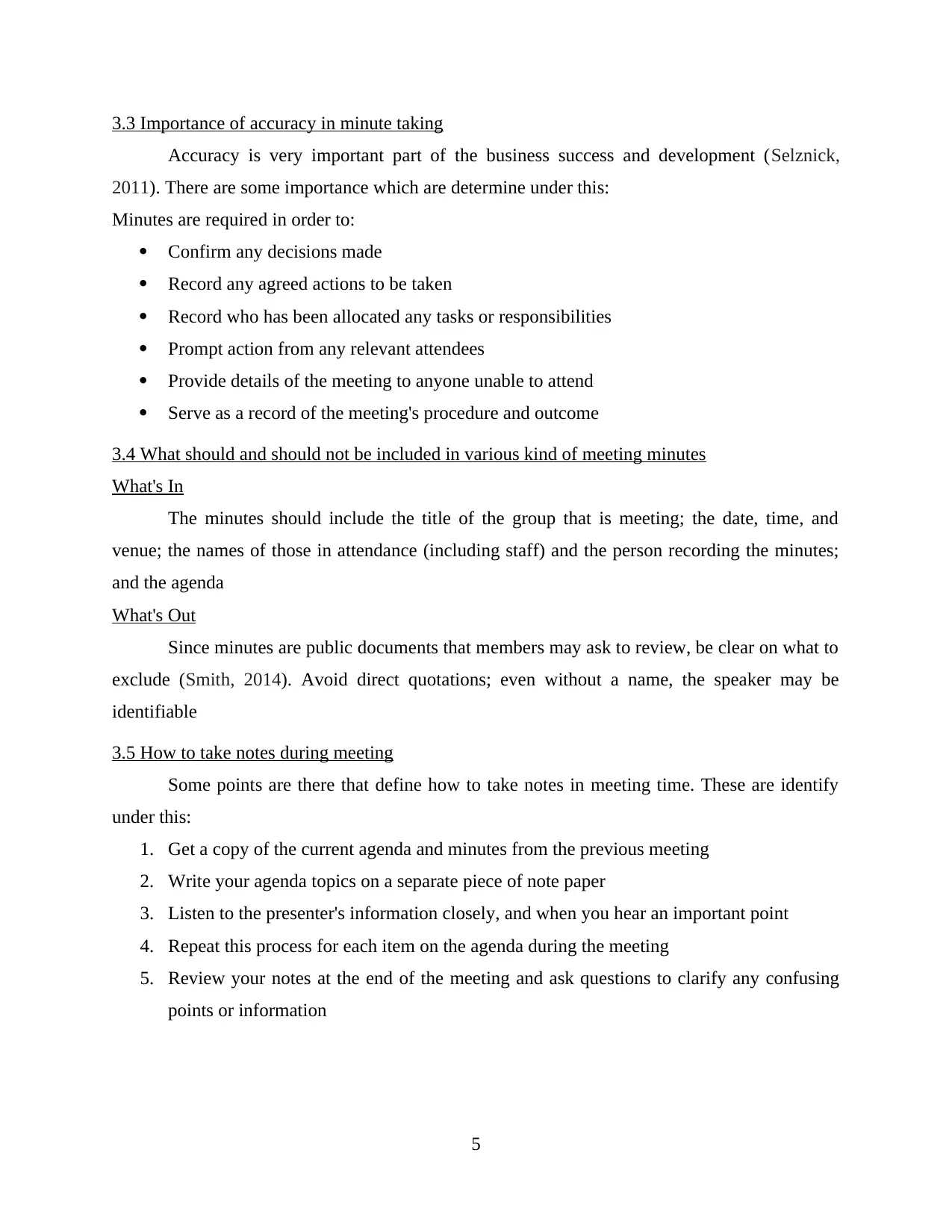
3.3 Importance of accuracy in minute taking
Accuracy is very important part of the business success and development (Selznick,
2011). There are some importance which are determine under this:
Minutes are required in order to:
Confirm any decisions made
Record any agreed actions to be taken
Record who has been allocated any tasks or responsibilities
Prompt action from any relevant attendees
Provide details of the meeting to anyone unable to attend
Serve as a record of the meeting's procedure and outcome
3.4 What should and should not be included in various kind of meeting minutes
What's In
The minutes should include the title of the group that is meeting; the date, time, and
venue; the names of those in attendance (including staff) and the person recording the minutes;
and the agenda
What's Out
Since minutes are public documents that members may ask to review, be clear on what to
exclude (Smith, 2014). Avoid direct quotations; even without a name, the speaker may be
identifiable
3.5 How to take notes during meeting
Some points are there that define how to take notes in meeting time. These are identify
under this:
1. Get a copy of the current agenda and minutes from the previous meeting
2. Write your agenda topics on a separate piece of note paper
3. Listen to the presenter's information closely, and when you hear an important point
4. Repeat this process for each item on the agenda during the meeting
5. Review your notes at the end of the meeting and ask questions to clarify any confusing
points or information
5
Accuracy is very important part of the business success and development (Selznick,
2011). There are some importance which are determine under this:
Minutes are required in order to:
Confirm any decisions made
Record any agreed actions to be taken
Record who has been allocated any tasks or responsibilities
Prompt action from any relevant attendees
Provide details of the meeting to anyone unable to attend
Serve as a record of the meeting's procedure and outcome
3.4 What should and should not be included in various kind of meeting minutes
What's In
The minutes should include the title of the group that is meeting; the date, time, and
venue; the names of those in attendance (including staff) and the person recording the minutes;
and the agenda
What's Out
Since minutes are public documents that members may ask to review, be clear on what to
exclude (Smith, 2014). Avoid direct quotations; even without a name, the speaker may be
identifiable
3.5 How to take notes during meeting
Some points are there that define how to take notes in meeting time. These are identify
under this:
1. Get a copy of the current agenda and minutes from the previous meeting
2. Write your agenda topics on a separate piece of note paper
3. Listen to the presenter's information closely, and when you hear an important point
4. Repeat this process for each item on the agenda during the meeting
5. Review your notes at the end of the meeting and ask questions to clarify any confusing
points or information
5
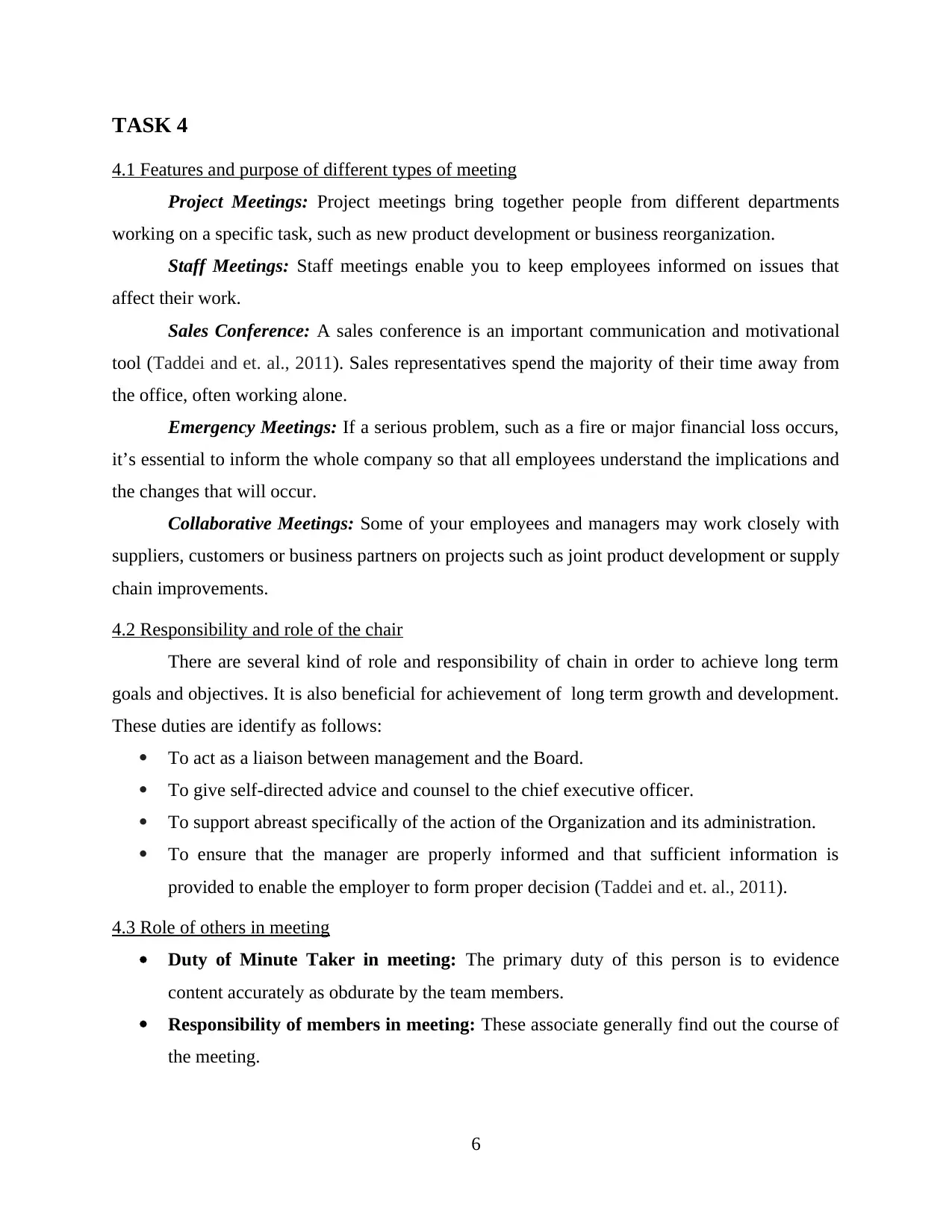
TASK 4
4.1 Features and purpose of different types of meeting
Project Meetings: Project meetings bring together people from different departments
working on a specific task, such as new product development or business reorganization.
Staff Meetings: Staff meetings enable you to keep employees informed on issues that
affect their work.
Sales Conference: A sales conference is an important communication and motivational
tool (Taddei and et. al., 2011). Sales representatives spend the majority of their time away from
the office, often working alone.
Emergency Meetings: If a serious problem, such as a fire or major financial loss occurs,
it’s essential to inform the whole company so that all employees understand the implications and
the changes that will occur.
Collaborative Meetings: Some of your employees and managers may work closely with
suppliers, customers or business partners on projects such as joint product development or supply
chain improvements.
4.2 Responsibility and role of the chair
There are several kind of role and responsibility of chain in order to achieve long term
goals and objectives. It is also beneficial for achievement of long term growth and development.
These duties are identify as follows:
To act as a liaison between management and the Board.
To give self-directed advice and counsel to the chief executive officer.
To support abreast specifically of the action of the Organization and its administration.
To ensure that the manager are properly informed and that sufficient information is
provided to enable the employer to form proper decision (Taddei and et. al., 2011).
4.3 Role of others in meeting
Duty of Minute Taker in meeting: The primary duty of this person is to evidence
content accurately as obdurate by the team members.
Responsibility of members in meeting: These associate generally find out the course of
the meeting.
6
4.1 Features and purpose of different types of meeting
Project Meetings: Project meetings bring together people from different departments
working on a specific task, such as new product development or business reorganization.
Staff Meetings: Staff meetings enable you to keep employees informed on issues that
affect their work.
Sales Conference: A sales conference is an important communication and motivational
tool (Taddei and et. al., 2011). Sales representatives spend the majority of their time away from
the office, often working alone.
Emergency Meetings: If a serious problem, such as a fire or major financial loss occurs,
it’s essential to inform the whole company so that all employees understand the implications and
the changes that will occur.
Collaborative Meetings: Some of your employees and managers may work closely with
suppliers, customers or business partners on projects such as joint product development or supply
chain improvements.
4.2 Responsibility and role of the chair
There are several kind of role and responsibility of chain in order to achieve long term
goals and objectives. It is also beneficial for achievement of long term growth and development.
These duties are identify as follows:
To act as a liaison between management and the Board.
To give self-directed advice and counsel to the chief executive officer.
To support abreast specifically of the action of the Organization and its administration.
To ensure that the manager are properly informed and that sufficient information is
provided to enable the employer to form proper decision (Taddei and et. al., 2011).
4.3 Role of others in meeting
Duty of Minute Taker in meeting: The primary duty of this person is to evidence
content accurately as obdurate by the team members.
Responsibility of members in meeting: These associate generally find out the course of
the meeting.
6
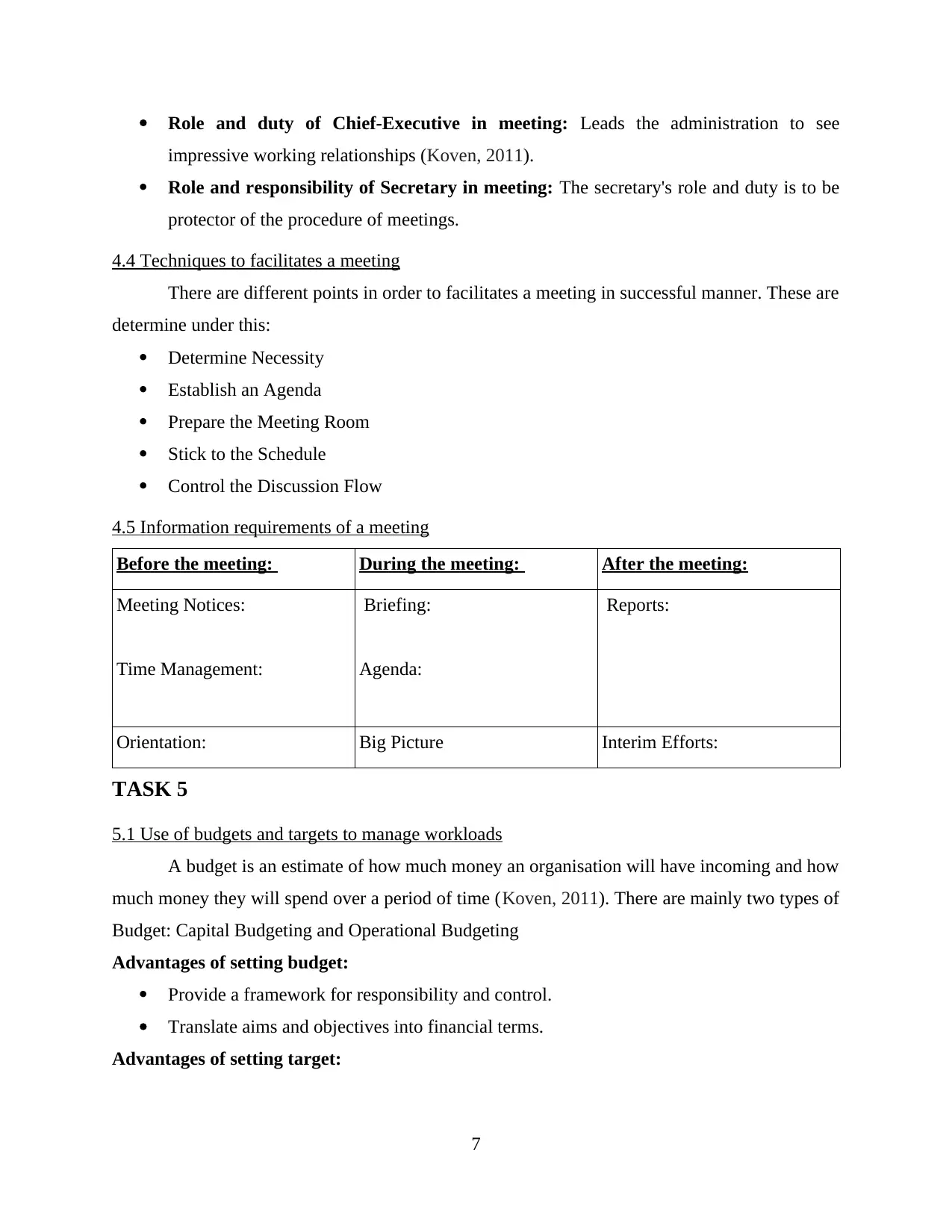
Role and duty of Chief-Executive in meeting: Leads the administration to see
impressive working relationships (Koven, 2011).
Role and responsibility of Secretary in meeting: The secretary's role and duty is to be
protector of the procedure of meetings.
4.4 Techniques to facilitates a meeting
There are different points in order to facilitates a meeting in successful manner. These are
determine under this:
Determine Necessity
Establish an Agenda
Prepare the Meeting Room
Stick to the Schedule
Control the Discussion Flow
4.5 Information requirements of a meeting
Before the meeting: During the meeting: After the meeting:
Meeting Notices:
Time Management:
Briefing:
Agenda:
Reports:
Orientation: Big Picture Interim Efforts:
TASK 5
5.1 Use of budgets and targets to manage workloads
A budget is an estimate of how much money an organisation will have incoming and how
much money they will spend over a period of time (Koven, 2011). There are mainly two types of
Budget: Capital Budgeting and Operational Budgeting
Advantages of setting budget:
Provide a framework for responsibility and control.
Translate aims and objectives into financial terms.
Advantages of setting target:
7
impressive working relationships (Koven, 2011).
Role and responsibility of Secretary in meeting: The secretary's role and duty is to be
protector of the procedure of meetings.
4.4 Techniques to facilitates a meeting
There are different points in order to facilitates a meeting in successful manner. These are
determine under this:
Determine Necessity
Establish an Agenda
Prepare the Meeting Room
Stick to the Schedule
Control the Discussion Flow
4.5 Information requirements of a meeting
Before the meeting: During the meeting: After the meeting:
Meeting Notices:
Time Management:
Briefing:
Agenda:
Reports:
Orientation: Big Picture Interim Efforts:
TASK 5
5.1 Use of budgets and targets to manage workloads
A budget is an estimate of how much money an organisation will have incoming and how
much money they will spend over a period of time (Koven, 2011). There are mainly two types of
Budget: Capital Budgeting and Operational Budgeting
Advantages of setting budget:
Provide a framework for responsibility and control.
Translate aims and objectives into financial terms.
Advantages of setting target:
7
Secure Best Marks with AI Grader
Need help grading? Try our AI Grader for instant feedback on your assignments.
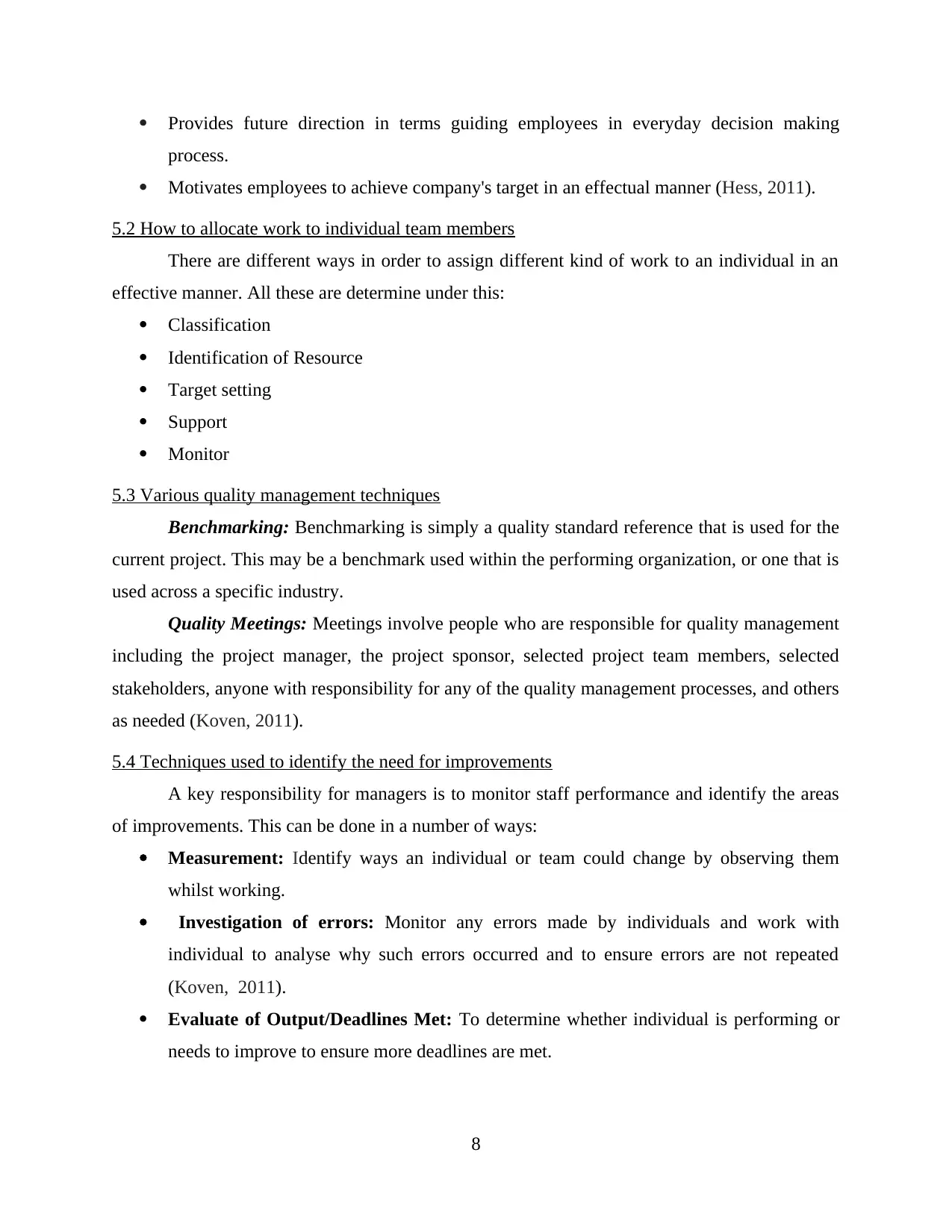
Provides future direction in terms guiding employees in everyday decision making
process.
Motivates employees to achieve company's target in an effectual manner (Hess, 2011).
5.2 How to allocate work to individual team members
There are different ways in order to assign different kind of work to an individual in an
effective manner. All these are determine under this:
Classification
Identification of Resource
Target setting
Support
Monitor
5.3 Various quality management techniques
Benchmarking: Benchmarking is simply a quality standard reference that is used for the
current project. This may be a benchmark used within the performing organization, or one that is
used across a specific industry.
Quality Meetings: Meetings involve people who are responsible for quality management
including the project manager, the project sponsor, selected project team members, selected
stakeholders, anyone with responsibility for any of the quality management processes, and others
as needed (Koven, 2011).
5.4 Techniques used to identify the need for improvements
A key responsibility for managers is to monitor staff performance and identify the areas
of improvements. This can be done in a number of ways:
Measurement: Identify ways an individual or team could change by observing them
whilst working.
Investigation of errors: Monitor any errors made by individuals and work with
individual to analyse why such errors occurred and to ensure errors are not repeated
(Koven, 2011).
Evaluate of Output/Deadlines Met: To determine whether individual is performing or
needs to improve to ensure more deadlines are met.
8
process.
Motivates employees to achieve company's target in an effectual manner (Hess, 2011).
5.2 How to allocate work to individual team members
There are different ways in order to assign different kind of work to an individual in an
effective manner. All these are determine under this:
Classification
Identification of Resource
Target setting
Support
Monitor
5.3 Various quality management techniques
Benchmarking: Benchmarking is simply a quality standard reference that is used for the
current project. This may be a benchmark used within the performing organization, or one that is
used across a specific industry.
Quality Meetings: Meetings involve people who are responsible for quality management
including the project manager, the project sponsor, selected project team members, selected
stakeholders, anyone with responsibility for any of the quality management processes, and others
as needed (Koven, 2011).
5.4 Techniques used to identify the need for improvements
A key responsibility for managers is to monitor staff performance and identify the areas
of improvements. This can be done in a number of ways:
Measurement: Identify ways an individual or team could change by observing them
whilst working.
Investigation of errors: Monitor any errors made by individuals and work with
individual to analyse why such errors occurred and to ensure errors are not repeated
(Koven, 2011).
Evaluate of Output/Deadlines Met: To determine whether individual is performing or
needs to improve to ensure more deadlines are met.
8
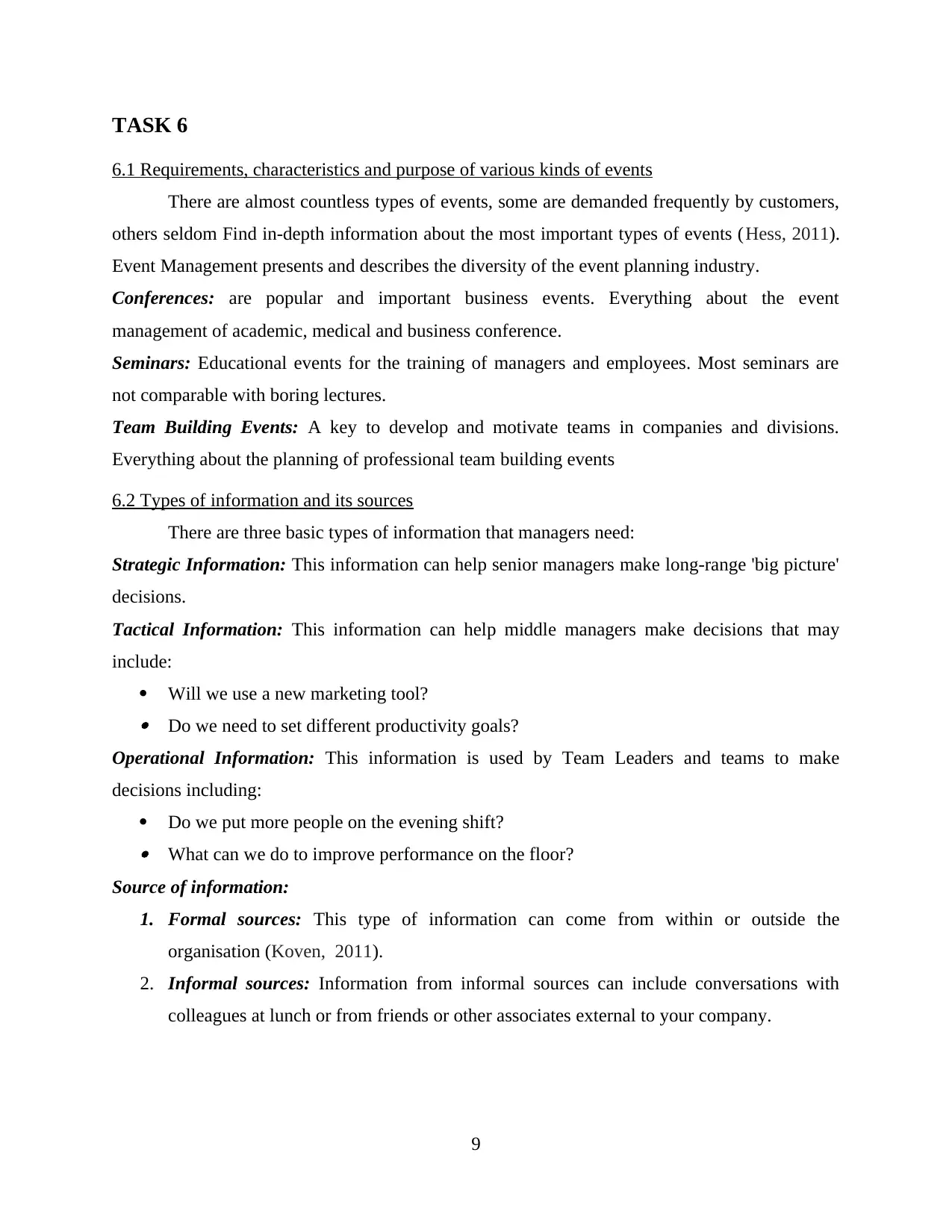
TASK 6
6.1 Requirements, characteristics and purpose of various kinds of events
There are almost countless types of events, some are demanded frequently by customers,
others seldom Find in-depth information about the most important types of events (Hess, 2011).
Event Management presents and describes the diversity of the event planning industry.
Conferences: are popular and important business events. Everything about the event
management of academic, medical and business conference.
Seminars: Educational events for the training of managers and employees. Most seminars are
not comparable with boring lectures.
Team Building Events: A key to develop and motivate teams in companies and divisions.
Everything about the planning of professional team building events
6.2 Types of information and its sources
There are three basic types of information that managers need:
Strategic Information: This information can help senior managers make long-range 'big picture'
decisions.
Tactical Information: This information can help middle managers make decisions that may
include:
Will we use a new marketing tool? Do we need to set different productivity goals?
Operational Information: This information is used by Team Leaders and teams to make
decisions including:
Do we put more people on the evening shift? What can we do to improve performance on the floor?
Source of information:
1. Formal sources: This type of information can come from within or outside the
organisation (Koven, 2011).
2. Informal sources: Information from informal sources can include conversations with
colleagues at lunch or from friends or other associates external to your company.
9
6.1 Requirements, characteristics and purpose of various kinds of events
There are almost countless types of events, some are demanded frequently by customers,
others seldom Find in-depth information about the most important types of events (Hess, 2011).
Event Management presents and describes the diversity of the event planning industry.
Conferences: are popular and important business events. Everything about the event
management of academic, medical and business conference.
Seminars: Educational events for the training of managers and employees. Most seminars are
not comparable with boring lectures.
Team Building Events: A key to develop and motivate teams in companies and divisions.
Everything about the planning of professional team building events
6.2 Types of information and its sources
There are three basic types of information that managers need:
Strategic Information: This information can help senior managers make long-range 'big picture'
decisions.
Tactical Information: This information can help middle managers make decisions that may
include:
Will we use a new marketing tool? Do we need to set different productivity goals?
Operational Information: This information is used by Team Leaders and teams to make
decisions including:
Do we put more people on the evening shift? What can we do to improve performance on the floor?
Source of information:
1. Formal sources: This type of information can come from within or outside the
organisation (Koven, 2011).
2. Informal sources: Information from informal sources can include conversations with
colleagues at lunch or from friends or other associates external to your company.
9
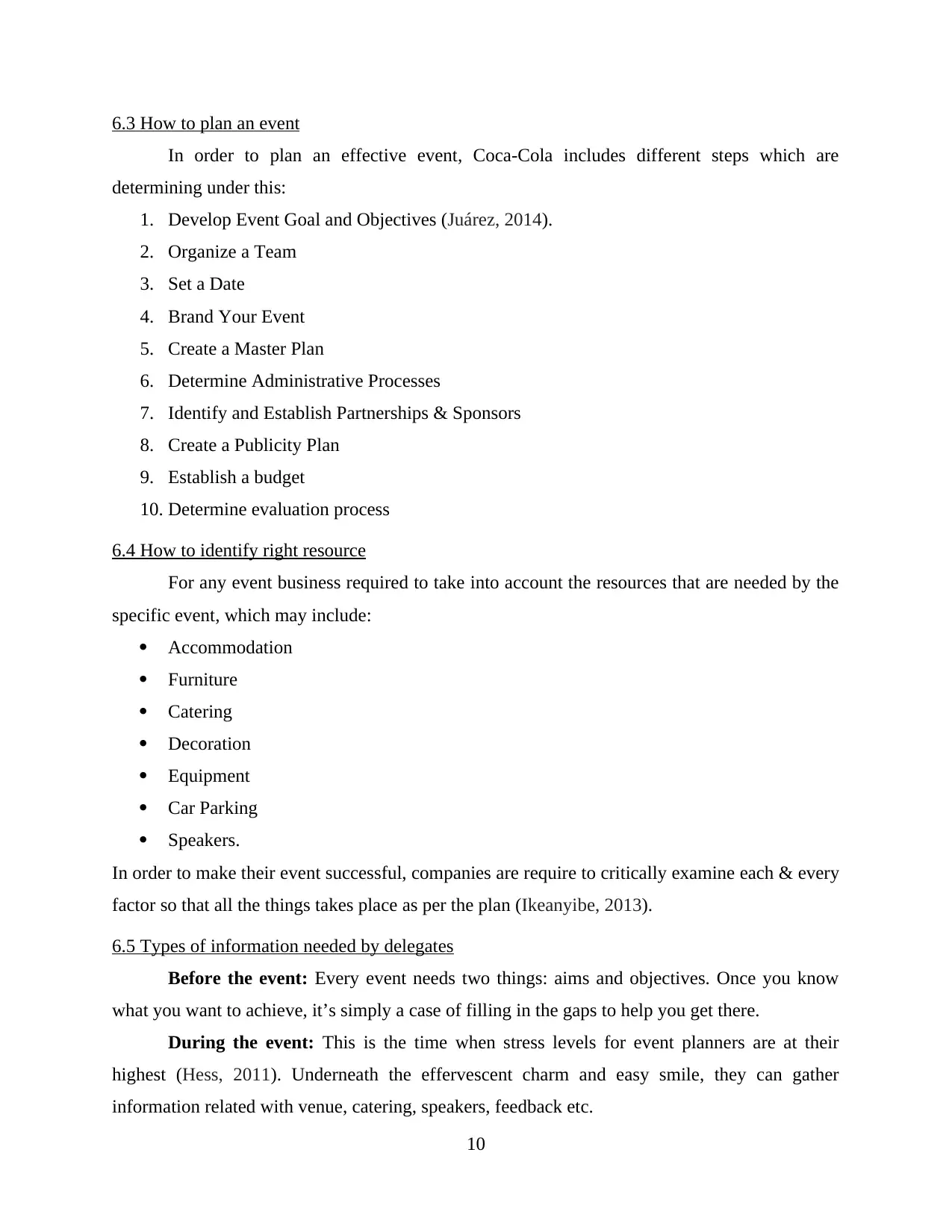
6.3 How to plan an event
In order to plan an effective event, Coca-Cola includes different steps which are
determining under this:
1. Develop Event Goal and Objectives (Juárez, 2014).
2. Organize a Team
3. Set a Date
4. Brand Your Event
5. Create a Master Plan
6. Determine Administrative Processes
7. Identify and Establish Partnerships & Sponsors
8. Create a Publicity Plan
9. Establish a budget
10. Determine evaluation process
6.4 How to identify right resource
For any event business required to take into account the resources that are needed by the
specific event, which may include:
Accommodation
Furniture
Catering
Decoration
Equipment
Car Parking
Speakers.
In order to make their event successful, companies are require to critically examine each & every
factor so that all the things takes place as per the plan (Ikeanyibe, 2013).
6.5 Types of information needed by delegates
Before the event: Every event needs two things: aims and objectives. Once you know
what you want to achieve, it’s simply a case of filling in the gaps to help you get there.
During the event: This is the time when stress levels for event planners are at their
highest (Hess, 2011). Underneath the effervescent charm and easy smile, they can gather
information related with venue, catering, speakers, feedback etc.
10
In order to plan an effective event, Coca-Cola includes different steps which are
determining under this:
1. Develop Event Goal and Objectives (Juárez, 2014).
2. Organize a Team
3. Set a Date
4. Brand Your Event
5. Create a Master Plan
6. Determine Administrative Processes
7. Identify and Establish Partnerships & Sponsors
8. Create a Publicity Plan
9. Establish a budget
10. Determine evaluation process
6.4 How to identify right resource
For any event business required to take into account the resources that are needed by the
specific event, which may include:
Accommodation
Furniture
Catering
Decoration
Equipment
Car Parking
Speakers.
In order to make their event successful, companies are require to critically examine each & every
factor so that all the things takes place as per the plan (Ikeanyibe, 2013).
6.5 Types of information needed by delegates
Before the event: Every event needs two things: aims and objectives. Once you know
what you want to achieve, it’s simply a case of filling in the gaps to help you get there.
During the event: This is the time when stress levels for event planners are at their
highest (Hess, 2011). Underneath the effervescent charm and easy smile, they can gather
information related with venue, catering, speakers, feedback etc.
10
Paraphrase This Document
Need a fresh take? Get an instant paraphrase of this document with our AI Paraphraser
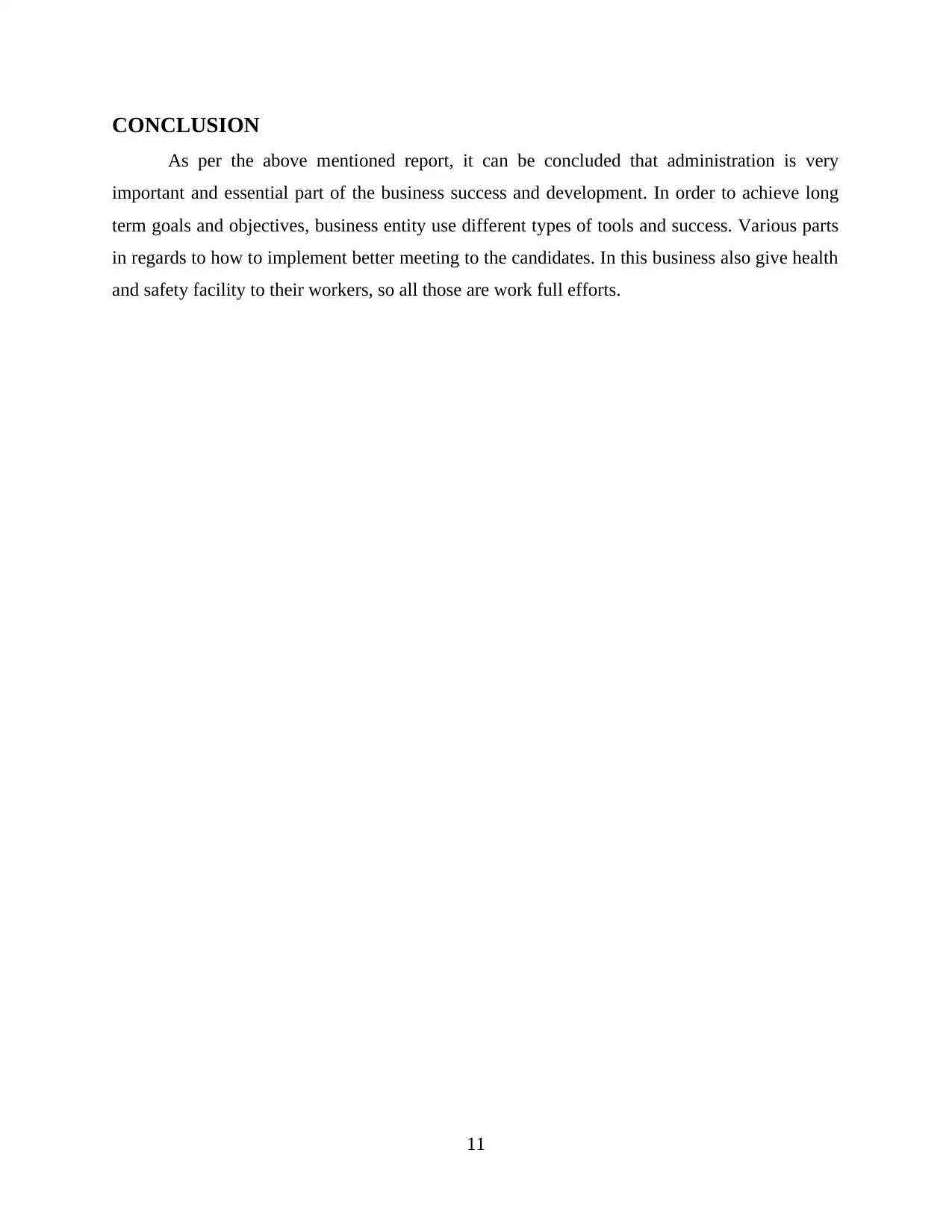
CONCLUSION
As per the above mentioned report, it can be concluded that administration is very
important and essential part of the business success and development. In order to achieve long
term goals and objectives, business entity use different types of tools and success. Various parts
in regards to how to implement better meeting to the candidates. In this business also give health
and safety facility to their workers, so all those are work full efforts.
11
As per the above mentioned report, it can be concluded that administration is very
important and essential part of the business success and development. In order to achieve long
term goals and objectives, business entity use different types of tools and success. Various parts
in regards to how to implement better meeting to the candidates. In this business also give health
and safety facility to their workers, so all those are work full efforts.
11
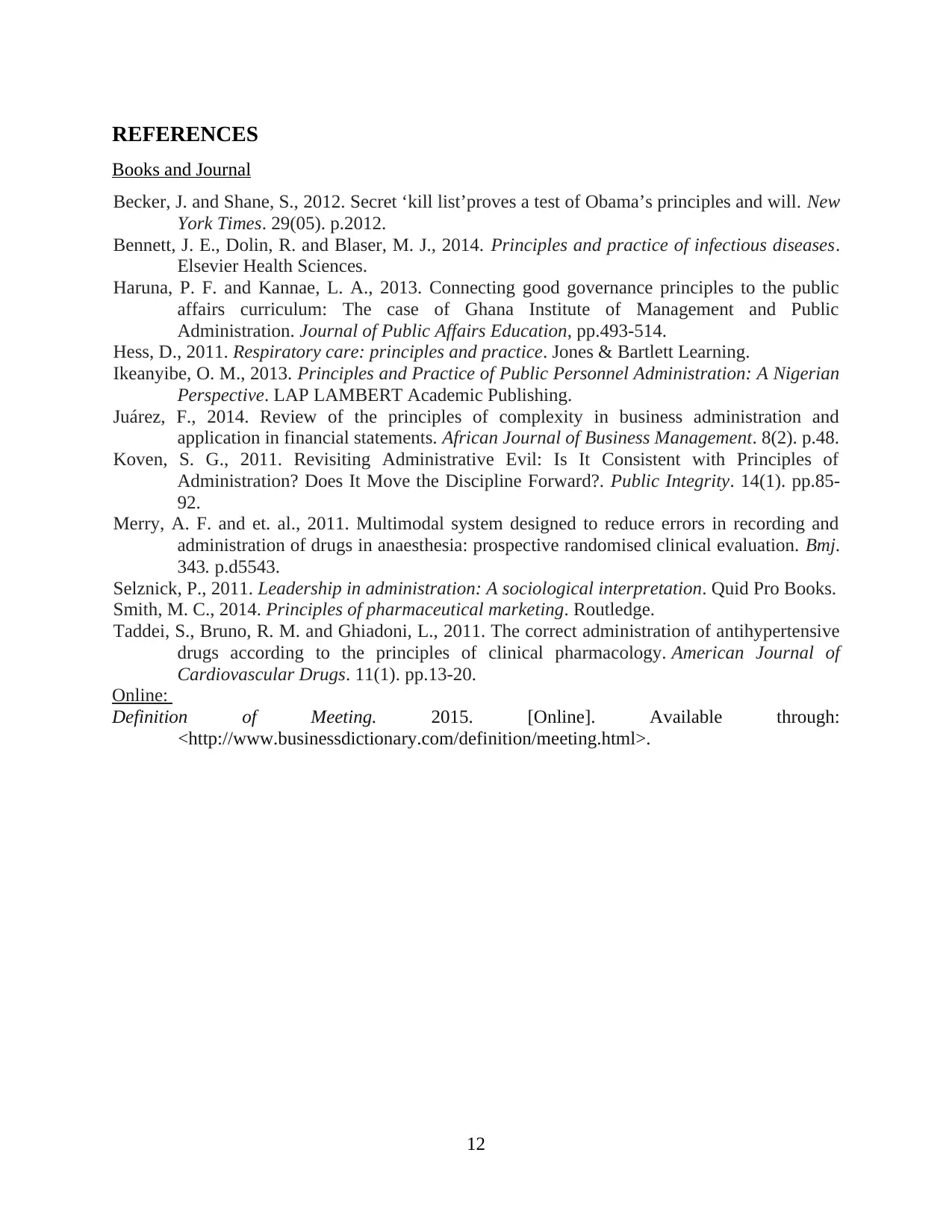
REFERENCES
Books and Journal
Becker, J. and Shane, S., 2012. Secret ‘kill list’proves a test of Obama’s principles and will. New
York Times. 29(05). p.2012.
Bennett, J. E., Dolin, R. and Blaser, M. J., 2014. Principles and practice of infectious diseases.
Elsevier Health Sciences.
Haruna, P. F. and Kannae, L. A., 2013. Connecting good governance principles to the public
affairs curriculum: The case of Ghana Institute of Management and Public
Administration. Journal of Public Affairs Education, pp.493-514.
Hess, D., 2011. Respiratory care: principles and practice. Jones & Bartlett Learning.
Ikeanyibe, O. M., 2013. Principles and Practice of Public Personnel Administration: A Nigerian
Perspective. LAP LAMBERT Academic Publishing.
Juárez, F., 2014. Review of the principles of complexity in business administration and
application in financial statements. African Journal of Business Management. 8(2). p.48.
Koven, S. G., 2011. Revisiting Administrative Evil: Is It Consistent with Principles of
Administration? Does It Move the Discipline Forward?. Public Integrity. 14(1). pp.85-
92.
Merry, A. F. and et. al., 2011. Multimodal system designed to reduce errors in recording and
administration of drugs in anaesthesia: prospective randomised clinical evaluation. Bmj.
343. p.d5543.
Selznick, P., 2011. Leadership in administration: A sociological interpretation. Quid Pro Books.
Smith, M. C., 2014. Principles of pharmaceutical marketing. Routledge.
Taddei, S., Bruno, R. M. and Ghiadoni, L., 2011. The correct administration of antihypertensive
drugs according to the principles of clinical pharmacology. American Journal of
Cardiovascular Drugs. 11(1). pp.13-20.
Online:
Definition of Meeting. 2015. [Online]. Available through:
<http://www.businessdictionary.com/definition/meeting.html>.
12
Books and Journal
Becker, J. and Shane, S., 2012. Secret ‘kill list’proves a test of Obama’s principles and will. New
York Times. 29(05). p.2012.
Bennett, J. E., Dolin, R. and Blaser, M. J., 2014. Principles and practice of infectious diseases.
Elsevier Health Sciences.
Haruna, P. F. and Kannae, L. A., 2013. Connecting good governance principles to the public
affairs curriculum: The case of Ghana Institute of Management and Public
Administration. Journal of Public Affairs Education, pp.493-514.
Hess, D., 2011. Respiratory care: principles and practice. Jones & Bartlett Learning.
Ikeanyibe, O. M., 2013. Principles and Practice of Public Personnel Administration: A Nigerian
Perspective. LAP LAMBERT Academic Publishing.
Juárez, F., 2014. Review of the principles of complexity in business administration and
application in financial statements. African Journal of Business Management. 8(2). p.48.
Koven, S. G., 2011. Revisiting Administrative Evil: Is It Consistent with Principles of
Administration? Does It Move the Discipline Forward?. Public Integrity. 14(1). pp.85-
92.
Merry, A. F. and et. al., 2011. Multimodal system designed to reduce errors in recording and
administration of drugs in anaesthesia: prospective randomised clinical evaluation. Bmj.
343. p.d5543.
Selznick, P., 2011. Leadership in administration: A sociological interpretation. Quid Pro Books.
Smith, M. C., 2014. Principles of pharmaceutical marketing. Routledge.
Taddei, S., Bruno, R. M. and Ghiadoni, L., 2011. The correct administration of antihypertensive
drugs according to the principles of clinical pharmacology. American Journal of
Cardiovascular Drugs. 11(1). pp.13-20.
Online:
Definition of Meeting. 2015. [Online]. Available through:
<http://www.businessdictionary.com/definition/meeting.html>.
12

13
1 out of 16
Related Documents
Your All-in-One AI-Powered Toolkit for Academic Success.
+13062052269
info@desklib.com
Available 24*7 on WhatsApp / Email
![[object Object]](/_next/static/media/star-bottom.7253800d.svg)
Unlock your academic potential
© 2024 | Zucol Services PVT LTD | All rights reserved.





